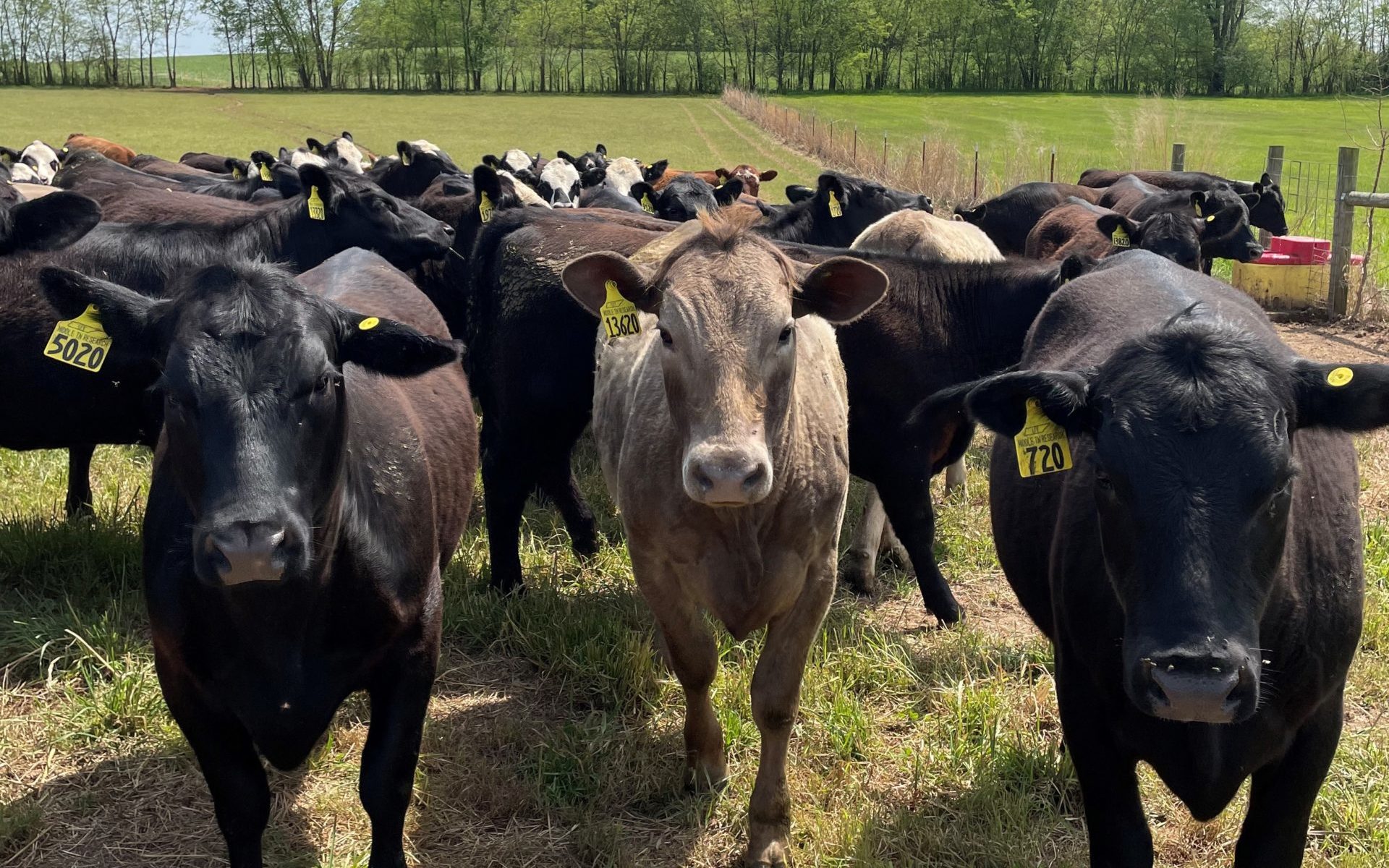

Dr. Troy Rowan
Assistant Professor
UTIA Genomics Center for the Advancement of Agriculture
P: 865-974-3190
Originally Published: Nebraska Cattlemen
Today’s commercial cattleman is left with an unprecedented amount of information when it comes to making sire selection decisions. This is for a good reason! Choosing the right (or wrong) sire can have a multi-generational impact on a cowherd. We expect bulls to sire well over 100 progeny throughout their lives. Assuming that a herd retains replacement females, it is easy to see how bull selection has a multi-generational impact. With the stakes being so high, operations must be equipped to interpret and use breed associations’ extensive suite of genetic predictions.
Some breed associations are reporting expected progeny differences (EPDs) for over 20 traits. These EPDs allow producers to make genetic progress on various phenotypes that impact their bottom lines: from calf weaning weight to marbling to heifer pregnancy to structural soundness. With such a wealth of resources, balancing the relative importance of each of these individual traits to an operation’s profitability becomes difficult. Performing effective multi-trait selection can be a real juggling act. Producers must account for multiple traits at once, some of which are more important than others. Further, these traits might share genetic correlations that can help or hurt a herd’s profitability. On top of all this, the relative importance of some traits might change based on economic conditions.
The difficulties surrounding multi-trait selection is a problem that has existed for as long as we have been breeding animals. In a groundbreaking paper in 1947, well before the first EPDs were published, LN Hazel proposed index-based selection. Indexes allow us to assign each trait’s relative importance to our breeding goal while accounting for genetic correlations. Since Hazel’s first paper, breed associations have integrated both EPDs (focusing solely on the genetic component of phenotypes) and economic weights with indexes. The resulting economic selection indexes can be interpreted as EPDs for profit. When comparing bulls from the same breed, differences in indexes are our predictions for per-calf profitability differences for a particular breeding goal. Economic weights represent the profit increase per unit increase of each EPD in the index. For example, an index designed for herds that sell weaned feeder calves and retains replacement females will place heavy economic weights on traits like weaning weight, stayability, and mature weight while putting no weight on post-weaning gain or carcass merit EPDs. These economic weights reflect on the predicted costs and revenue sources for a generalized herd. While these values may not perfectly represent each herd, generalized indexes allow almost all commercial producers to accurately rank sires by their potential to improve the herd’s profitability.

Economic selection indexes can be one of three types based on production systems: Maternal, Terminal, and All-Purpose. Maternal indexes are focused on improving profitability in herds that retain females and sell calves at weaning. Maternal indexes place heavy weights on EPDs cow longevity, fertility, and maintenance while improving calf weaning weights. Terminal indexes are designed for commercial producers that retain ownership of their calves and market them on a merit-based carcass grid. These indexes assume that the producer does not keep replacement females and emphasizes feedlot performance and increasing carcass merit. All-Purpose indexes assume that producers both retain ownership of some animals and keep replacement females. Identifying the correct index for your particular operation requires a well-thought-out breeding plan. Using the wrong selection index can cause serious problems. For example, using a terminal index in a herd that keeps replacement females and markets at weaning is counterproductive. No emphasis is placed on pre-weaning growth or maternal traits, the two things paramount to that operation’s profitability.
While I won’t go into extensive detail on each breed’s indexes, below is a table with many associations’ indexes, their names/symbols, progeny endpoints, and the breeding system for which they are designed.
| Breed | Index Name | Progeny Endpoint | Breeding System |
| Angus | $W (Weaning) | weaned feeder calves | All-Purpose |
| Angus | $M (Maternal) | replacement heifers | Maternal |
| Angus | $F (Feedlot) | live fed cattle | Terminal |
| Angus | $G (Grid) | beef carcasses sold on a grid | Terminal |
| Angus | $B (Beef) | beef carcasses from retained ownership sold on a grid | Terminal |
| Angus | $C (Composite) | beef carcass sold on a grid; replacement heifers retained | All-Purpose |
| Charolais | TSPI (Terminal Sire Profitability Index) | beef carcass sold on a grid | Terminal |
| Gelbvieh | $Cow | replacement heifers | Maternal |
| Gelbvieh | CV (Carcass Value) | beef carcass sold on a grid | Terminal |
| Gelbvieh | FM (Feedlot Merit) | live fed cattle | Terminal |
| Hereford | BMI$ (Baldy Maternal Index) | beef carcass sold on a grid; replacement heifers retained | All-Purpose |
| Hereford | BII$ (Brahman Influence Index) | beef carcass sold on a grid; replacement heifers retained | All-Purpose |
| Hereford | CHB$ (Certified Hereford Beef Index) | beef carcass sold on CHB grid | Terminal |
| Hereford | CEZ$ (Calving Ease Index) | matings to replacement heifers | Maternal |
| Limousin | MTI (Mainstream Terminal Index) | beef carcasses sold on a grid | Terminal |
| Red Angus | Profitability Sustainability Index | beef carcass sold on a grid; replacement heifers retained | All-Purpose |
| Red Angus | HerdBuilder | replacement heifers retained | Maternal |
| Red Angus | GridMaster | beef carcasses sold on a grid | Terminal |
| Simmental | API (All-Purpose Index) | beef carcasses sold on a grid; replacements retained | All-Purpose |
| Simmental | TI (Terminal Index) | beef carcasses sold on a grid | Terminal |
When choosing a selection index to utilize, it is essential to consider which traits are included in its calculation. Breed associations often report tables with relative weights for the traits included in the index, and reviewing these is essential before using an index to rank selection candidates. For example, even when using an index aligned with your breeding goals, it is important to know whether it includes other traits you are attempting to make genetic progress on (e.g., feet and legs, heifer pregnancy, etc.).
Selection indexes are constantly changing and improving. Breed associations regularly review their economic weights and recalibrate based on industry needs. For example, when grain prices increase, a terminal index will more heavily weight Dry Matter Intake and Average Daily Gain EPDs as they have grown in economic importance. For other traits, we know that continued increases don’t always result in increased profitability. This is especially true with phenotypes like calving ease and milk. Once we consistently have 70 lb calves, additional selection for reducing birth weight likely doesn’t contribute to added profitability. Other traits, like milk, are often best in moderation due to their problematic correlations with other traits (i.e., mature cow size and energy requirements) that impact the profitability of a sire’s offspring.
Moving forward, we can expect to see economic selection indexes change and adapt to fit the needs of the beef industry. For example, the Angus Association has released indexes designed to rank sires in Beef x Dairy crossbreeding programs. Other breeds, like the American Hereford Association, have developed marketing programs around their selection indexes. In these cases, breed associations provide additional opportunities for commercial producers to market calves from elite index value sires at a premium.
While bull selection is still a significant decision for any commercial producer, selection indexes make the process as straightforward as possible. Indexes are best used as an initial way to identify selection candidates (i.e., choosing a top group of bulls based on an index) before more refined sorting on other pieces of information (individual EPDs, physical appearance, price). Using indexes is as easy as an EPD, but they encompass multiple traits contributing to an animal’s overall profitability. As we strive to ensure that beef cattle production remains a profitable and sustainable enterprise, selection indexes will be a critical tool moving forward.
